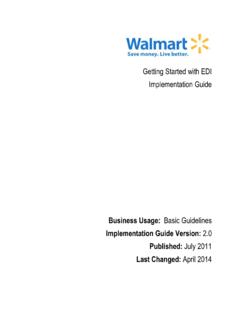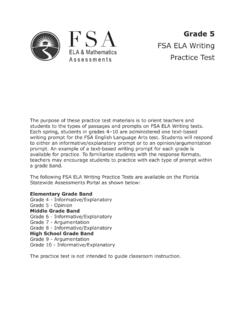Transcription of Building your Portfolio of Evidence and Reflective …
1 Building your Portfolio of Evidence and Reflective @ourATT on2 Building your Portfolio OF Evidence AND Reflective STATEMENTThis guidance will help you build the Portfolio of Evidence needed for your end-point assessment. It will help you work out what to put in your Portfolio and how to organise the Evidence . The guidance will also help you organise your Training Log, and outline what is required for your Reflective Statement, which must be included with your Portfolio . INTRODUCTIONWho does what in Building the Portfolio of EvidenceThe Portfolio is one of two requirements needed for the end-point assessment. The second requirement involves undertaking a Role Simulation assessment. There is a separate guidance resource to help you prepare for this called Getting Ready for the Role Simulation . Building your Portfolio AND Reflective STATEMENTAT T provides clear guidance to let you know what is requiredAT T will have two independent assessors assess your Portfolio of Evidence to determine training provider will carry out regular progress reviews with you, if your employer chooses to delegate this training provider will review the quality and sufficiency of the Evidence you are employer creates the opportunities that allow you to generate Evidence that demonstrates your employer will also review your progress and decide when you are ready for end-point must:Generate and select the Evidence for your Portfolio of your Portfolio and Training a Reflective Portfolio and Reflective Statement Building your Portfolio OF Evidence AND Reflective STATEMENT 3 The Portfolio is made up of two types of Evidence .
2 L your best work l your account of your learning and skills development journeyYOUR BEST WORKThe apprenticeship allows you to have the space and time needed to learn and develop your skills. You do not need to start putting Evidence together straight away. When you are ready and can start to apply what has been learned in the workplace, then you will be ready to start Building your Portfolio of Evidence . WHAT SHOULD I PUT IN MY Portfolio OF Evidence ?WHAT IS A Portfolio OF Evidence ?A Portfolio of Evidence is a repository for the work that best demonstrates that you can apply the knowledge and skills, and demonstrate the behaviours identified in the apprenticeship standard. So, the Portfolio of Evidence contains the proof that you have attained, and can apply, the knowledge, skills and behaviours defined in the apprenticeship standard. Types of secondary Evidence to consider using to demonstrate your abilitiesYour best work will:l Demons trate your attainment of the knowledge, skills and behaviours identified in the apprenticeship standardl Show you applying your learning and skills l Con tain substantial real work tasks that you have completed.
3 These will need to be suitably anonymised if specific client details are of primary Evidence to consider using to demonstrate your abilities:l Work-based products or servicesl Pr esentations you makel Y our contributions to wider team workWitness testimony is a useful way to authenticate work as your own and to provide Evidence that is difficult to capture in a physical form. For example, some performance of tasks at a client s place of testimony acts as:l A w ay of supporting something you have done but cannot evidencel E vidence for something important, but not central to your portfoliol A supplement to other Evidence of the same knowledge, skills and behaviours, here is the Evidence and here is a witness testimony saying that I also did the same thing at another timeClient testimony serves a similar purpose to witness testimony from your employer or training provider because it is independent.
4 It can be used to support your performance in delivering a better client service or your behaviour, knowledge and ability when supporting Testimony from your manager/supervisor or on-programme training providerClient testimonyEVIDENCE WHAT IT DEMONSTRATES WELL4 Building your Portfolio OF Evidence AND Reflective STATEMENTBUILDING your Portfolio AND Reflective STATEMENTCONTINUEDYou must be conscious of the following principles of assessment when you build your Portfolio of Evidence , in order to make sure it adequately demonstrates the knowledge, skills and Valid evidenceThe Evidence presented should be an appropriate way of demonstrating the abilities you want to show. So, if you want to demonstrate that you can apply tax knowledge to consistently deliver high quality, accurate data and information in a timely fashion, the Evidence presented should be of you doing this. 2. Authentic evidenceThe Evidence must be your own work.
5 When you provide a personal statement as Evidence of an achievement, you will need to have your manager/supervisor sign it as an accurate reflection of events. Where workplace Evidence is used in your Portfolio of Evidence , this must be your own work. 3. Current evidenceThe Evidence should be recent enough to be considered to be a current indication of your knowledge, skills and behaviours. 4. Sufficient evidenceYou need to have enough of the right kind of Evidence in your Portfolio of Evidence . This starts with making sure everything produced is at a Level 4 LOGEVIDENCE OF your LEARNING AND SKILLS DEVELOPMENT JOURNEY your Portfolio of Evidence must include more than just indicators of achievement or demonstrations of competence. It should also capture Evidence of the learning and skills development journey you have been on, as well as your reflections on your learning journey.
6 This aspect of the Portfolio is delivered through your :l Training Logl R eflective StatementLevel 4 standards involve identifying, adapting and using skills to inform your actions and address problems that are well-defined, but are complex and potentially non-routine. You will also reflect on the effectiveness and appropriateness of methods used, actions taken and results achieved. What is a Training Log?It is a record of your work and the Evidence you are generating. It also indicates which parts of the apprenticeship standard you have learned and applied in your workplace. So, it records how you are developing your knowledge and skills, and builds up over time as you learn and develop more and more skills and competencies. What is it designed to do? The Training Log will show whether you are developing the knowledge, skills and behaviours required to meet the Professional Taxation Technician Standard, as planned.
7 your Training Log will chart your progress while you are doing the on-programme part of the apprenticeship. Use it to identify and record examples of your work that demonstrate that you have applied what you have learned. You can use your Training Log as the basis for your progress review discussions. Building your Portfolio OF Evidence AND Reflective STATEMENT 5 Reflective STATEMENTGETTING started The following questions and tips will help get you started :l Wha t was your starting point at the beginning of the apprenticeship? l What learning took place in the workplace? Were there any opportunities to work in other areas of the business?l Pick 3-6 of the best examples from your Portfolio and share: What they are and how you did them Wha t they demonstrate in relation to the apprenticeship standard What went well Wha t would you do differently next time (what lessons were learned)?
8 What did you learn that surprised you?l R emember the need for confidentiality of information, data and client privacy. You need to make sure any Evidence collected and anything you have referenced in your Reflective Statement has been suitably you could move on to:l What challenged you? l How did you meet the challenge?l Wha t would you do differently if you have a chance to do this project again? Why?l What have you discovered about yourself as a learner?Here s a checklist for your Reflective Statement. Make sure:l It is written in as a clear and concise a way as possible and that it is understandable to the readerl It is filled with factual knowledge, as well as your personal opinionl It lacks biasl It contains insights into your learningl It reveals the decision-making process you used in the most difficult DOES A Reflective STATEMENT LOOK LIKE?This will be a written statement that will be made up of your own reflections on what you have done, how you did it, what you would have done differently and what you have learned throughout the Portfolio Building process.
9 It needs to be around 2,000 to 3,000 words. At the centre of the Reflective Statement has to be a process of critical analysis with you thinking about, and sharing your thoughts on, your work and your learning. Synonyms for efficacy: Effectiveness; usefulness; worth; value; impactSynonyms for reflection: Consideration, thinking, contemplation, deliberation, musingsWhat is a Reflective Statement?The Reflective Statement is a piece of Evidence allowing you to look back on what you have learned and done, and to share your thoughts on it. It will involve honesty, critical analysis of your performance and a chance to demonstrate integrity (one of the behaviours identified in the apprenticeship standard) in how you approach this work. What is it designed to do? It is designed to show you can honestly appraise your performance and look at the impact the whole experience has had on you.
10 The concept at the heart of this is efficacy . The focus of the assessment is not how many faults you find; it is how well you are able to honestly appraise your work. Have you the maturity to look at your work honestly and say how you could make it even better?A common mistake would be to either be too objective, or to be too emotional. Whilst you will need to analyse your personal feelings, to be a good statement there needs to be a balance struck to ensure it is personal to each individual and reflects on all the training contact the ATT to discuss alternative arrangements if there are special considerations that mean a written Reflective Statement might not be MAKES A GOOD Reflective STATEMENT?A good Reflective statement will have:1. AnalysisThis will involve recalling important learning events during the apprenticeship and considering how these events shaped where you are now and how they were beneficial.




